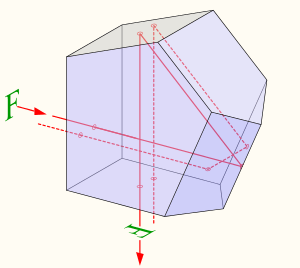Roof prism
A roof prism (also called a Dach prism or Dachkanten prism, from the German: "Dachkante", lit. roof edge) is a reflective optical prism containing a section where two faces meet at a 90° angle. These two 90° faces resemble the roof of a building, giving this prism type its name. Reflection from the two 90° faces returns an image that is flipped laterally across the axis where the faces meet.


Characteristic for a roof prism is that the beam is split in half, with one half of the beam hitting first one face then the other face, while it is invert for the other half of the beam. Therefore, a roof prism can be used only with some distance to focal planes, or the "edge" of the roof would introduce slight distortions. Furthermore, the angle between the two faces has to be very close to 90°, or image quality would be degraded.
The simplest roof prism is the Amici roof prism, with other common roof prism designs being the Abbe–Koenig prism, the Schmidt–Pechan prism and probably the best known being the roof pentaprism pictured here. A porro prism is not a roof prism, contrary to popular notion, as the two 90° faces usually don't meet in a Porro prism and therefore don't form a roof edge.
Phase correction
The multiple internal reflections cause a polarization-dependent phase-lag of the transmitted light, in a manner similar to a Fresnel rhomb. This must be suppressed by multilayer phase-correction coatings applied to one of the roof surfaces to avoid unwanted interference effects and a loss of contrast in the image.
In a roof prism without a phase-correcting coating, s-polarized and p-polarized light each acquire a different geometric phase as they pass through the upper prism. When the two polarized components are recombined, interference between the s-polarized and p-polarized light results in a different intensity distribution perpendicular to the roof edge as compared to that along the roof edge. This effect reduces contrast and resolution in the image perpendicular to the roof edge, producing an inferior image compared to that from a porro prism erecting system. This roof edge diffraction effect may also be seen as a diffraction spike perpendicular to the roof edge generated by bright points in the image.
This effect can be seen in the elongation of the Airy disk in the direction perpendicular to the crest of the roof as this is a diffraction from the discontinuity at the roof crest.
The unwanted interference effects are suppressed by vapour-depositing a special dielectric coating known as a phase-compensating coating on the roof surfaces of the roof prism. This coating corrects for the difference in geometric phase between s- and p-polarized light so both have effectively the same phase shift, preventing image-degrading interference.